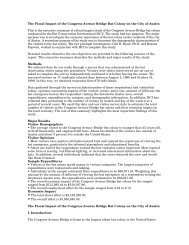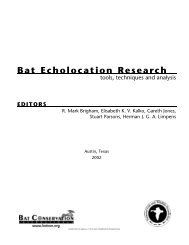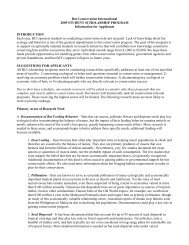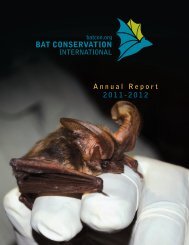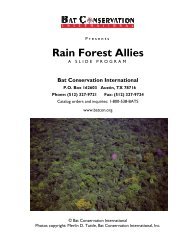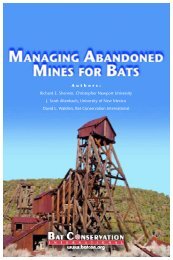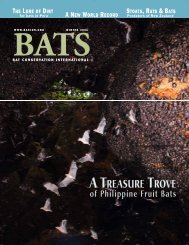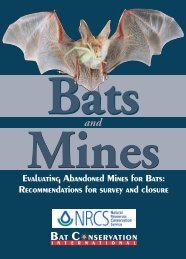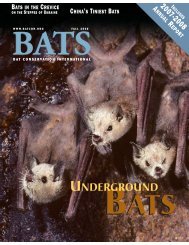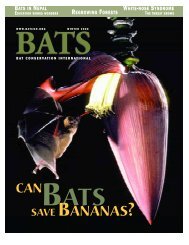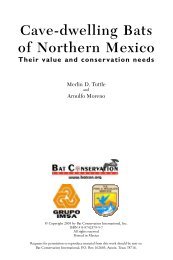Bat Conservation and Management Workshop
Bat Conservation and Management Workshop
Bat Conservation and Management Workshop
Create successful ePaper yourself
Turn your PDF publications into a flip-book with our unique Google optimized e-Paper software.
BCI <strong>Bat</strong> <strong>Conservation</strong> <strong>and</strong> <strong>Management</strong> <strong>Workshop</strong> – Arizona<br />
passages often provide especially suitable temperature<br />
gradients for winter hibernation.<br />
It is rare for any one cave to provide sufficient thermal<br />
complexity for year-round occupation; seasonal<br />
migration between caves is usually necessary for bats<br />
which use caves year-round (see Tuttle, 1976). Two<br />
caves discussed in this paper, however, are important<br />
to bats both in winter <strong>and</strong> summer. The cave<br />
(discussed in the section on Nonreversing Air Flow)<br />
from which the readings in Figure 4 were taken<br />
houses one of the largest winter populations of Myotis<br />
grisescens known, as well as a sizeable summer<br />
bachelor colony of the species. The hibernation roosts<br />
are in areas of the cave which are protected from<br />
freezing but are well ventilated by cool winter air; the<br />
summer roosts are in warm areas much higher in the<br />
cave.<br />
The second such cave, Cave 1 of Figure 2, contains<br />
the largest summer colony of Myotis grisescens<br />
known. The main roost, located in the dome-like area<br />
around H, is warmed by the summer air sucked in<br />
from entrance K by the strong air circulation<br />
discussed previously, <strong>and</strong> by the body heat of the<br />
colony of 128,000 bats (formerly more than 250,000).<br />
In winter, the appendix-like area (F), due to its<br />
configuration <strong>and</strong> location, traps <strong>and</strong> stores air of low<br />
temperature, providing a hibernation roost of<br />
relatively constant temperature for a number of bat<br />
species, including M. grisescens <strong>and</strong> M. sodalis.<br />
MANAGEMENT IMPLICATIONS<br />
Choosing Caves for Protection<br />
Clearly, knowledge of cave structure <strong>and</strong> its relation<br />
to temperature <strong>and</strong> humidity is of potentially great<br />
importance in predicting species distributions within<br />
<strong>and</strong> among caves, <strong>and</strong> in determining the relative<br />
merits of any given cave for protection. Data on such<br />
factors as number, size, shape <strong>and</strong> location of<br />
entrances, internal passage size, contour <strong>and</strong> slope,<br />
distribution <strong>and</strong> amount of volume relative to cave<br />
entrances, <strong>and</strong> source <strong>and</strong> amount of water flow (if<br />
any), can be used to predict <strong>and</strong>/or verify the probable<br />
seasonal temperature <strong>and</strong> humidity regime of a cave.<br />
Given the limitations of resources, time <strong>and</strong><br />
manpower, it often is important to establish criteria for<br />
recognition of caves of special or unique merit.<br />
Obviously no single structural type can be singled out<br />
for exclusive protection, since each cave type presents<br />
a potentially different setting for the evolution of<br />
different faunas <strong>and</strong> survival strategies. In fact, a wide<br />
variety of cave types should be protected. For example,<br />
caves that are good for bat hibernation may not be good<br />
for some terrestrial cavernicoles, <strong>and</strong> vice versa.<br />
Frequently the object of cave protection is centered around<br />
one or two endangered species. In such situations it is vital<br />
to ascertain not only the species' temperature, humidity,<br />
<strong>and</strong> other microhabitat requirements, but also its food<br />
requirements <strong>and</strong> sources when relevant, in order to<br />
guarantee that all important parameters are adequate.<br />
For bats, when food supply availability <strong>and</strong> other external<br />
variables are equal, caves of greatest structural <strong>and</strong><br />
therefore thermal complexity generally are best.<br />
Nevertheless, in the case of maternity colonies, where<br />
warmth is of primary concern, even simple caves (for<br />
example cave 3, Figure 2) may be of great importance.<br />
Also, in the case of endangered bats, their present usage of<br />
a cave often is not a reliable indicator of its suitability for<br />
use. The best caves often have been heavily disturbed <strong>and</strong><br />
now contain very few bats. On the other h<strong>and</strong>, other<br />
nearby caves, of very marginally suitable temperature but<br />
less disturbed, may contain more bats. In many cases the<br />
most important cave, in terms of the species' longterm<br />
survival, is the one that presently has few bats.<br />
A good example is illustrated in Figure 3. As a result of<br />
this cave's popularity with local cavers, it has not housed<br />
major bat populations for perhaps as long as 50 or more<br />
years. Although no bats were present at the time of our<br />
visit, scattered recent droppings indicated that some bats<br />
continue to visit the cold area at night in the summer <strong>and</strong><br />
probably in the fall. If the cave were protected, it could<br />
potentially become an important bat hibernating site, as it<br />
undoubtedly once was prior to disturbance. In addition to<br />
its cold trap characteristics, which make it suitable for<br />
hibernation, there is evidence (in the form of feces) in the<br />
warmest area, which indicates that some bats continue to<br />
attempt to use the area as a summer roost. Similarities<br />
with known roosts suggest that the species involved may<br />
be Plecotus rafinesquii. In this case as in many others,<br />
then, the cave's structure <strong>and</strong> resulting environment can<br />
tell more about its importance to bat populations than does<br />
its present degree of usage. This is almost certain to be<br />
true for caves valuable to other animals as well.<br />
Means of Protecting Caves<br />
Knowledge of factors affecting cave environments also is<br />
of great importance in determining the proper means of<br />
cave protection. In a number of instances, improper gating<br />
of caves has reduced or destroyed the bat populations<br />
intended for protection, either through reducing free<br />
access by the bats or reducing the air flow necessary for<br />
© 2011 – <strong>Bat</strong> <strong>Conservation</strong> International Page 33



